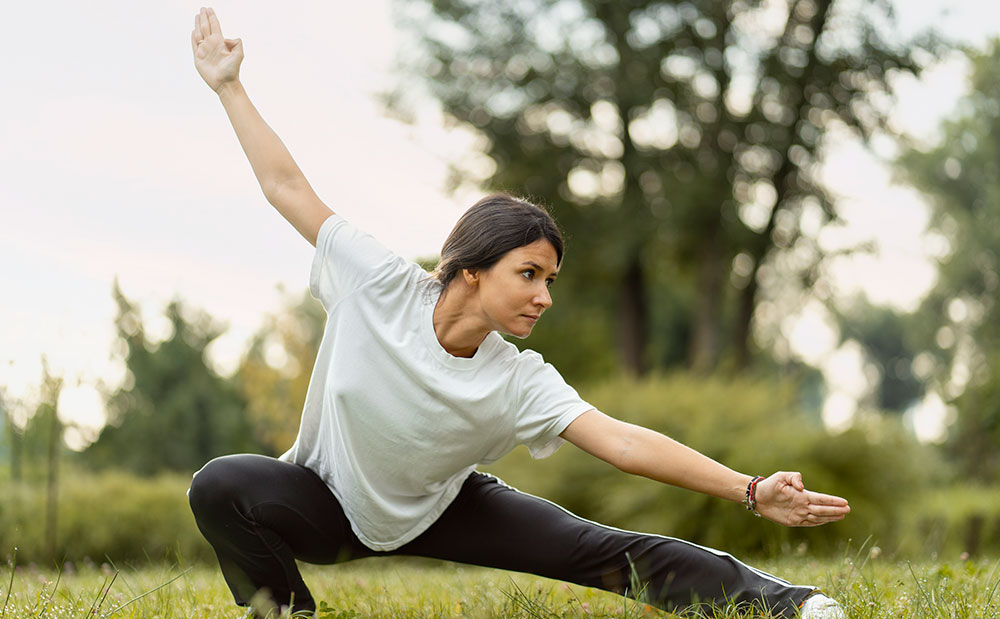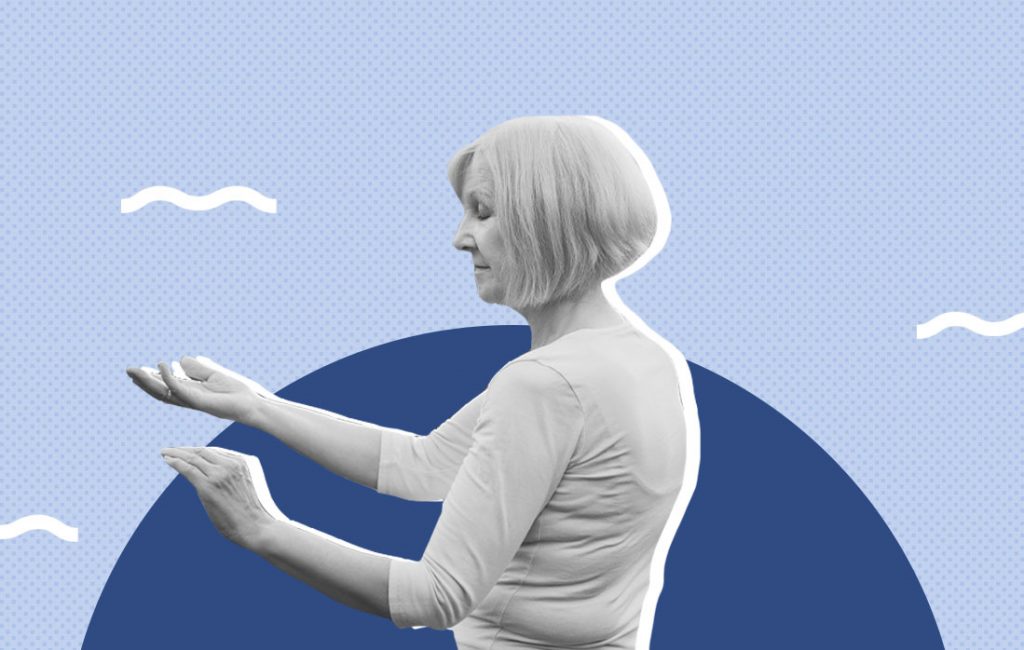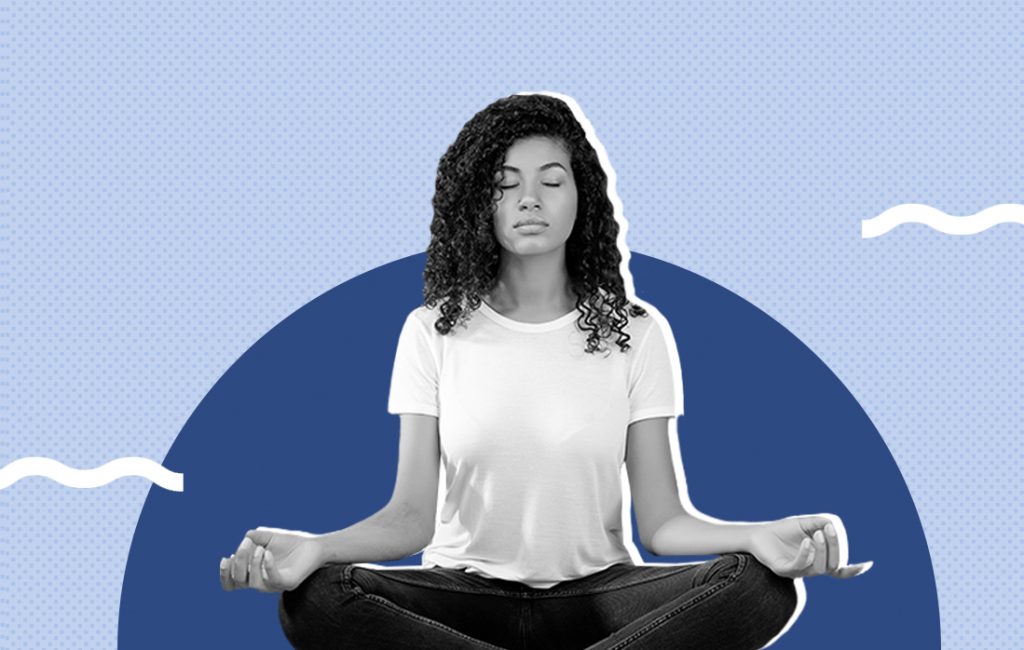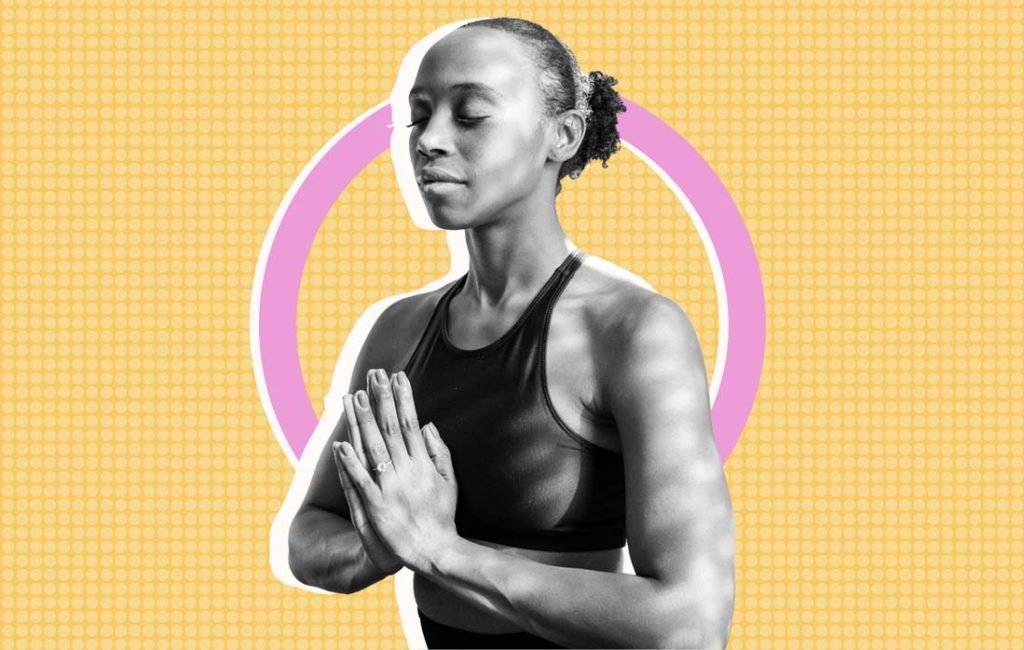
If there’s one universal truth about sleep, it’s that we’re not getting enough of it. And if you’re even sort of paying attention, you know that every few months, some new research study or Gallup poll comes out that drives that point home — again. Whether it’s packaged as “half of Americans don’t get enough sleep” or “one-third of Americans are sleep deprived,” the song remains the same. And while a sleep mocktail or melatonin may sound promising, there may be a simpler approach. Taking it back to the basics, here’s what you need to know about tai chi for sleep.
Note: The content on Sleepopolis is meant to be informative in nature, but it shouldn’t be taken as medical advice, and it shouldn’t take the place of medical advice and supervision from a trained professional. If you feel you may be suffering from any sleep disorder or medical condition, please see your healthcare provider immediately.
Long Story Short
- Tai chi is a moving meditation that combines graceful movement with breath control.
- Tai chi can help improve sleep quality because it calms the mind, reduces stress, and promotes relaxation.
- Other bedtime relaxation techniques for better sleep include meditation, yoga, and focused breathing.
What Is Tai Chi?
Tom Ingegno, DACM, a licensed Baltimore acupuncturist, expert in Chinese Medicine and founder of Charm City Integrative Health, tells Sleepopolis, “Tai chi (also known as tai chi chuan, which loosely translates to supreme ultimate boxing) is a traditional Chinese martial art that combines slow, graceful movements with breath control and meditation.”
Noting that tai chi is often (and beautifully, we might add) described as “meditation in motion.” Ingegno explains, “Tai chi is based on the principles of yin and yang and the flow of qi (life energy) through the body.”
If you’re curious how something like “supreme ultimate boxing” can be associated with sleep, Ingegno says, “It originated as a martial art outside of China, but today tai chi is primarily practiced for its health benefits, which include improved balance, flexibility, strength, and relaxation.”
How Tai Chi Improves Sleep
According to Ingegno, “Tai chi has been shown to help improve sleep quality. The slow, gentle movements and deep breathing practiced in tai chi can help calm the mind, reduce stress and anxiety, and promote relaxation, ultimately making it easier to fall asleep and stay asleep throughout the night.”
There’s research to support that claim, too. While a 2018 study concluded that slow, deep breathing techniques can be more effective at combating insomnia than sleep medications, a more recent study involving 60 older adults found that tai chi may improve subjective reported sleep quality, extend sleep duration, and optimize sleep architecture, ultimately improving overall sleep quality. (1) (2)
What Is Sleep Architecture?
Sleep architecture refers to the structural organization of your sleep, or the stages of sleep that make up the sleep cycle.
In addition to improved sleep, Ingegno says tai chi may offer practitioners a whole host of physiological benefits, including:
Stress reduction: Tai chi’s meditative aspects may help lower stress and anxiety — common culprits in sleep disturbances. (3)
Relaxation: Tai chi breathing techniques and slow, flowing movements associated with the practice can promote physical and mental relaxation, which may make it easier to wind down before bed. (4)
Improved mood: Tai chi has been linked to improved mood and reduced symptoms of depression, which can contribute to better sleep. (3)
Pain relief: For those whose sleep is disrupted by chronic pain conditions, tai chi’s gentle movements may help alleviate pain and stiffness, leading to more restful sleep. (5)
Enhanced body awareness: Tai chi may foster a mind-body connection that can make practitioners more attuned to their body’s signals, including feelings of sleepiness.
Tai Chi for Sleep

For those interested in practicing tai chi exercises before bedtime, we asked a few experts to share their favorites.
Vinay Amin of Eu Natural: Rising and Falling
- Stand up straight with your arms at your side and your feet positioned slightly wider than shoulder-width.
- For the rising breath, inhale through your nose. As you do this, gradually lift your hands in front of your body. Once you reach the top of your breath, your hands should be at shoulder height.
- For the falling breath, exhale through your nose, slowly dropping your arms, bending your knees, and lowering your hips. Maintain your posture while dropping into a squat that you can easily hold. At the bottom of the breath, your hands should be by your side and you should be in a quarter squat.
- Gently inhale again, letting your breath fill your body as you slowly stand and lift your hands. This is a single full cycle. He recommends beginning with 30 to 40 cycles. Each inhale and exhale should become progressively longer. As you breathe, focus on how your breath fills your rising body and empties as you fall.
Personal trainer, Brandon Nicholas of The Fitness Tribe: Circling Arms Form
- Stand with your feet shoulder-width apart, making sure your weight is evenly distributed across your feet.
- Cross your arms with your palms facing your body.
- Inhale, slowly raising your arms over your head and clasping your hands.
- Exhale as you slowly lower your arms in a circling movement until they are at the starting position.
- Repeat these steps until you feel relaxed.
Certified Wellness Coach, Lynell Ross: Back Twist
- Stand with your feet pointing forward.
- Move your body towards one side for as far as you can bend.
- Move your body back so you are standing normally.
- Move your body towards the other side.
- Return to your upright position.
- Repeat this several times.
Meditation for Sleep

“Meditation can help with sleep by reducing stress, anxiety, and racing thoughts, which are common barriers to falling asleep,” says Ingegno. (6) (7) “It promotes relaxation, lowers heart rate, and calms the mind, creating an ideal internal environment for sleep. And while more research may be needed, existing studies show that “regular meditation can also improve sleep quality and duration.” (8)
For those looking for some help with meditating for sleep, Ingegno walks us through one technique: Progressive Muscle Relaxation (it might remind some of you of the viral military sleep hack!).
- Lie down comfortably in your bed, on your back, with your arms relaxed at your sides.
- Close your eyes and take a few deep breaths, noticing the sensation of the breath moving in and out of your body.
- Starting from your toes, progressively relax each part of your body. Focus on releasing tension from your feet, legs, hips, torso, arms, hands, neck, and face. You may imagine that they are all getting progressively heavier, sinking into the bed while you focus on that area.
- Once you feel relaxed, begin a simple breathing meditation. Count each exhalation, starting from one and going up to ten. If you lose count, simply start again from one.
- If thoughts arise, gently acknowledge them and return your focus to your breathing and counting.
- Continue this process until you drift off to sleep. If you reach ten without falling asleep, start counting again from one.
- Remember, the goal is to relax and let sleep come naturally, not to force it. With regular practice, meditation can become a valuable tool for improving sleep quality and duration.
Yoga for Sleep

Radha Metro-Midkiff, executive director at Integral Yoga Institute New York, says, “Yoga can enhance sleep quality by reducing stress, soothing the nervous system, and alleviating physical discomfort that might impede sleep.” (9) She adds, “The practice of yoga increases physical tiredness and promotes mental relaxation, both of which are conducive to better sleep.”
Metro-Midkiff explains, “Practicing a soothing form of yoga close to bedtime can be particularly beneficial, as it helps calm the mind and body before sleep. However, yoga at any time of day can contribute to better sleep quality due to its overall stress-reducing and health-enhancing effects.”
According to Metro-Midkiff, some of the best sleep-promoting yoga poses are:
- Child’s Pose (Balasana)
- Legs Up the Wall (Viparita Karani)
- Corpse Pose (Savasana)
To learn how to do these poses (and more), check out our guide to yoga for sleep.
Breathing Exercises for Sleep
Noting that there’s clearly some overlap between the relaxation practices outlined here, Ingegno says, “Focused breathing can also help with sleep by activating the parasympathetic nervous system, which is responsible for the body’s “rest and digest” response.” Physically and mentally, he says it can “slow down the heart rate, lower blood pressure, and promote a sense of calm. (9)
For those seeking sleep, Ingegno explains that “by focusing on the breath, you can quiet the mind, reduce stress and anxiety, and create a conducive internal environment for sleep.”
Ingegno tells us there are many excellent breathing techniques for sleep, but the two he finds particularly useful are the 4-7-8 Breathing Technique and Diaphragmatic Breathing (Belly Breathing). Ahead, he walks us through each.
4-7-8 Breathing
- Sit comfortably with your back straight or lie down
- Place the tip of your tongue against the ridge behind your upper front teeth.
- Exhale completely through your mouth, making a whoosh sound.
- Close your mouth and inhale quietly through your nose for a count of 4.
- Hold your breath for a count of 7.
- Exhale completely through your mouth, making a whoosh sound for a count of 8.
- Repeat this cycle three more times for a total of four breaths.
Diaphragmatic Breathing (Belly Breathing)
- Lie down comfortably on your back, with a pillow under your head and knees.
- Place one or both hands just below your belly button.
- Inhale slowly through your nose, letting your belly rise, and push your hand up. Your chest should remain relatively still.
- Exhale slowly through pursed lips, letting your belly fall and your hand lower. Again, your chest should remain relatively still.
- Continue this pattern, focusing on the sensation of your breath moving in and out of your body.
- Aim for 6 to 10 deep, slow breaths per minute for 10 minutes or longer.
“As with any new skill, consistency is key,” says Ingegno. “Regularly practicing these breathing techniques before bed can help signal to your body that it’s time to relax and prepare for sleep. The more you practice these techniques, the more effective they’ll become in promoting better sleep.”
Other Bedtime Relaxation Techniques
Alternate Nostril Breathing
Lynette Suchar, a yoga and meditation teacher at studio BE, says alternate-nostril breathing before bedtime can help calm your nervous system. (10) To practice alternate nostril breathing:
- Use your right hand to place your index finger at the left nostril crease and your thumb at the right nostril crease. Don’t squeeze yet.
- Close the left nostril with your index finger and breathe through your right nostril.
- Close the right nostril and exhale through your left nostril.
- Inhale through the open left nostril and exhale through the right.
- Repeat this for five to ten rounds.
Body Scanning
In another type of progressive relaxation, Ingegno says, restless sleepers can also try body scanning.
- Start with the head. Breathe slowly and deeply, while keeping your focus on your head.
- Imagine your head is either slowly melting away, sinking into the ground, or simply softening and relaxing.
- Repeat the process working your way down the body from the neck, chest and upper back, upper arms, forearms, hands, abdomen, hips, legs, and feet,
“The idea is that you are spending attention on each area to allow for relaxation at that specific location,” says Ingegno. “Sometimes people like to imagine they are full of sand and there are holes at the bottom of their feet. As the sand slowly drains out the head becomes relaxed and you follow the sand out of the body until you are “empty.”
FAQs
Can tai chi help you sleep?
Tai chi can help improve sleep quality. Tai chi breathing techniques and slow, gentle movements can help calm the mind, reduce stress and anxiety, and promote relaxation, making it easier to fall asleep and stay asleep throughout the night.
Should I do tai chi before bed?
According to Ingegno, you can absolutely do tai chi before bed. “It’s even recommended to practice tai chi before bed as part of a bedtime routine,” he says. “The meditative effects of tai chi can help signal to your body and mind that it’s time to wind down.”
For those incorporating tai chi into their bedtime routines, Ingegno warns, “Just be sure not to practice too vigorously or for too long right before bed, as this could have a stimulating rather than relaxing effect.” He adds, “A gentle 10-20 minute practice is ideal, and folks should allow some time between practice and getting into bed, so the body settles as well.”
The Last Word From Sleepopolis
The established rules of good sleep hygiene tell us that a solid bedtime routine can help you improve your sleep. And while rigorous exercise may be a bit much, the light stretching and focused breathing that lie at the heart of tai chi may be just what you need to catch some quality shuteye.
Sources
- Jerath R, Beveridge C, Barnes VA. Self-Regulation of Breathing as an Adjunctive Treatment of Insomnia. Front Psychiatry. 2019;9:780. Published 2019 Jan 29. doi:10.3389/fpsyt.2018.00780
- Wang, C., Jiang, T., Li, H., Cao, G., & Zhang, G. (2024, January 31). The effects of tai chi exercise on sleep quality among the elderly: A study based on polysomnographic monitoring. Frontiers. https://www.frontiersin.org/journals/neurology/articles/10.3389/fneur.2024.1304463/full
- Sani NA, Yusoff SSM, Norhayati MN, Zainudin AM. Tai Chi Exercise for Mental and Physical Well-Being in Patients with Depressive Symptoms: A Systematic Review and Meta-Analysis. Int J Environ Res Public Health. 2023;20(4):2828. Published 2023 Feb 5. doi:10.3390/ijerph20042828
- Yang M, Yang J, Gong M, Luo R, Lin Q, Wang B. Effects of Tai Chi on Sleep Quality as Well as Depression and Anxiety in Insomnia Patients: A Meta-Analysis of Randomized Controlled Trials. Int J Environ Res Public Health. 2023;20(4):3074. Published 2023 Feb 9. doi:10.3390/ijerph20043074
- Wood RC. Tai Chi as a method of improving pain management in patients with fibromyalgia. Lifestyle Med. 2020; 1:e13. https://doi.org/10.1002/lim2.13
- Petersen, H., Kecklund, G. and Åkerstedt, T. (2023), Disturbed sleep and its attribution to stress and other causes: A population-based survey. Scand J Psychol, 64: 99-104. https://doi.org/10.1111/sjop.12867
- Arora, Rohan; Gupta, Reshu. Effectiveness of meditation programs in empirically reducing stress and amplifying cognitive function, thus boosting individual health status: A narrative overview. Indian Journal of Health Sciences and Biomedical Research (KLEU) 14(2):p 181-187, May–Aug 2021. | DOI: 10.4103/kleuhsj.kleuhsj_108_20
- Rusch HL, Rosario M, Levison LM, et al. The effect of mindfulness meditation on sleep quality: a systematic review and meta-analysis of randomized controlled trials. Ann N Y Acad Sci. 2019;1445(1):5-16. doi:10.1111/nyas.13996
- Panjwani U, Dudani S, Wadhwa M. Sleep, Cognition, and Yoga. Int J Yoga. 2021;14(2):100-108. doi:10.4103/ijoy.IJOY_110_20
- Kamath A, Urval RP, Shenoy AK. Effect of Alternate Nostril Breathing Exercise on Experimentally Induced Anxiety in Healthy Volunteers Using the Simulated Public Speaking Model: A Randomized Controlled Pilot Study. Biomed Res Int. 2017;2017:2450670. doi:10.1155/2017/2450670
Amin, Vijay. Author Interview with Paul Watson. 2023
Ingegno, Tom. Author Interview. April 30, 2024
Metro-Midkiff, Radha. Author Interview. April 30, 2024
Nicholas, Brandon. Author Interview with Paul Watson. 2023
Ross, Lynelle. Author Interview with Paul Watson. 2023
Suchar, Lynette. Author Interview with Paul Watson. 2023


























